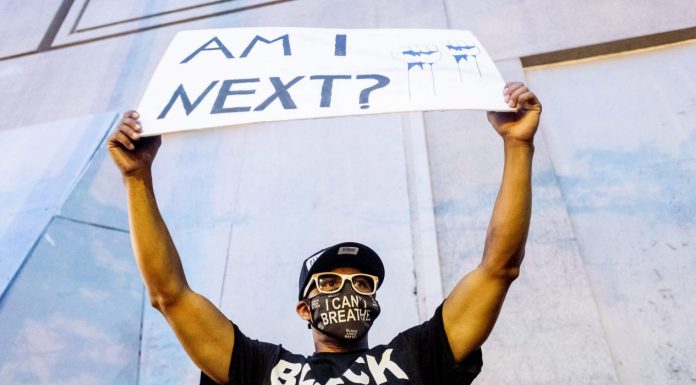(Headline USA) After George Floyd’s death in the custody of Minneapolis police, people in Portland came out in droves to protest police brutality and racism, chanting that “black lives matter.”
As the weeks went by, the crowds dwindled to a few dozen and the protests increasingly turned violent.
But ever since militarized federal agents arrived in the far-left city early this month to maintain order and safeguard federal property, the numbers of protesters have swelled again.
Thousands of mostly white demonstrators, including mothers wearing yellow shirts and dads armed with leaf blowers to drive away tear gas, join in chants like “Feds go home!”
Sometimes, they also call for racial justice, led by black protesters with megaphones.
For the most part, though the catalyzing event—the public outrage over Floyd and other innocent victims of color due to “systemic racism”—has spun off in many other directions, leaving the original movement something of an afterthought.
Coming Together, Falling Apart
Skeptics and critics wonder if that weren’t the plan all along.
Well before the deaths of Floyd, Ahmaud Arbery, Breonna Taylor and Rayshard Brooks spurred the latest public action, radical activists such as those backing the campaign of Sen. Bernie Sanders had promised violent clashes to come.
Such efforts seem, in recent campaign cycles, to have become something of a pattern that onlookers could set their watches to.
The anti-war demonstrations during the George W. Bush years gave way to the Occupy Wall Street anti-capitalist movement of the 2012 Barack Obama–Mitt Romney campaign.
The racial discord in the waning years of Obama’s second term all seemed to coalesce in violent anti-Trump clashes as organized and—in some cases—well-paid groups like Black Lives Matter and Antifa found their audience and coordinated their efforts.
Radical feminist groups like Code Pink and socialist organizations found their respective niches also.
Rally around the Rage

The opposing figurehead seems immaterial—weak and “compassionate” moderates like Bush and Romney were just as apt as anyone to be denounced as Nazis by the unruly mobs.
However, President Donald Trump’s refusal to capitulate has mobilized the resistance effort even more, helping the radical hate-groups to coalesce around a common political enemy.
The lackluster appeal of presumptive Democrat alternative Joe Biden makes ginning up fury among left-wing extremists even more of an imperative.
The success of Democrat organizers in unifying these conflicting interests in service of a singular outcome can, however, be a double-edged sword.
Apart from a few vague, reductive slogans and talking points, few in the crowd seem fully capable of articulating just what it is they are angry about—much less presenting viable solutions that extend beyond early November.
Instead of violence and chaos being a means to an end, they have become the end itself as protesters violently protest the fact that federal authorities won’t allow them to protest even more violently and destructively.
Ironically, the rhetoric against federal intervention mirrors closely that of Confederate figures, whom many in the mob have recently demanded must be obliterated from the nation’s history books for their traitorous 19th-century rebellion.
Blacks to the Back?
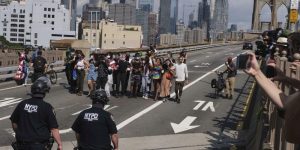
Historically speaking, the Left’s appropriation of black suffering to attain ulterior political objectives—forcing loyal minority foot-soldiers into a more subservient role in favor of priorities that are, if not counter-productive, at the very least irrelevant—has a long history of its own.
Once again, black leaders agreed that they didn’t mind taking a back seat over something as important as swapping Trump for Biden.
In Portland, black leaders insist the recent surge in activity—though often chaotic—hasn’t distracted from their anti-racist message. Instead, it’s shined a spotlight on it.
Portland City Commissioner Jo Ann Hardesty, the first black woman elected to that office, rejected the idea that the Black Lives Matter protests are being hijacked by white people.
“We cannot afford not to respond to this attack on our democracy, this attack on our Constitution,” Hardesty said.
“And we would be foolish to believe that we could stay focused just on black lives and not address the physical assaults that are taking place,” she added.
Unburdened in the Burbs
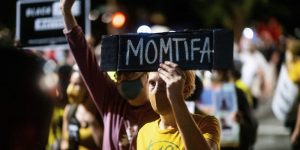
Those attending the protests are overwhelmingly white, a reflection of Oregon’s makeup.
Its population is only 2% black, compared with 13% for the entire U.S., largely due to the state’s racist past. Its Constitution excluded Blacks from living in Oregon until the clause was repealed in 1927.
For white liberals, witnessing the anarchy that has taken root in cities like Seattle and Portland offers an immersive experience better than any safari.
Better yet, it helps them to assuage and ameliorate the crushing guilt of their own privilege upon returning to the affluent suburbs where they have priced out many minority residents.
By being subjected to tear gas, nightsticks and pepper spray, “white people are stepping up and they’re seeing the brutality” that back people normally experience, said white protester Carol Vogel Warner. “They’re feeling it.”
Warner said she felt so deep a sense of empathy and obligation to take up the cause that she adopted a black son, following the lead of celebrities like Angelina Jolie who, likewise, have accented their own families with the adoption of underprivileged children of color.
Nice to Be Noticed
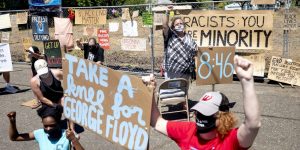
Some back protesters say that white people who have been throwing water bottles at law enforcement and causing vandalism are setting back the movement.
“When we ask people to stop, they don’t. I have been pushed tonight. I have been shoved tonight. I have been told to shut up,” Portland demonstrator Julianne Jackson said. “If white people want to help us, this is not helping us.”
For most black Democratic leaders, though, the opportunity to help newly “woke” whites experience vicariously the pain of systemic racism and police brutality makes it all worthwhile.
State Sen. Lew Frederick, who’s dodged pepper balls fired by federal agents at the protests, said the Trump administration “miscalculated” if it thought it could end the demonstrations with a show of force.
“It reignited the protest movement in Portland,” Frederick said, adding that he’s seen more black people demonstrating now than in the early days.
Even this week, with the nation focused on the deployment of the federal agents and their tactics, white protesters chanted the names of Floyd, Breonna Taylor and others who have been killed by police.
Vogel Warner said thousands of people stopped marching Monday to remember them.
“We all raised a hand and we had some moments of silence, offering either prayers or chants or our silent love to those people who died,” she recalled.
Just the Beginning…
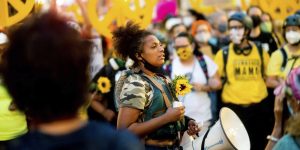
The intervention in Oregon could be just the beginning of a clash between the Trump administration and Democratic leaders in cities nationwide who refuse to bar rioters from engaging in lawless conduct.
During the recent anarchist takeover in Seattle, two lives were lost due to shootings that first-responders couldn’t get to.
It was only then that Mayor Jenny Durkin decided to use local authorities to shut it down, although several stragglers resisted for days afterward.
The economic damage for private businesses that have been looted and vandalized, piled on to the losses from pandemic-related closures, also has been immense.
The White House announced this week that federal agents also will deploy to Chicago, Cleveland, Detroit, Milwaukee and Albuquerque, New Mexico, to combat rising crime.
Yet, the Movement for Black Lives, a coalition of more than 150 black-led organizations across the U.S., said it remains “undeterred.”
“As we witness Portland becoming a war zone, we understand clearly that this is an attempt to intimidate not just protesters on the streets of Portland but to derail our movement in defense of [b]lack lives,” said Chinyere Tutashinda, a coalition organizer.
In the end, though, the movement all comes down to money and power—two areas where black leaders still must look to their benevolent white allies for help and support.
The protests are just one prong of the move to end police violence and racial discrimination and serve underserved communities, Frederick said. Another is changing laws and providing assistance.
After Floyd’s death, Oregon lawmakers passed police accountability measures proposed by the People of Color Caucus, to which Frederick belongs.
And on July 14, 10 days after the federal deployment in Portland, lawmakers provided $62 million in federal coronavirus relief funding to black people and businesses affected by the pandemic.
“That’s because of the People of Color Caucus and the kind of momentum that has been fostered,” Frederick said.
Adapted from reporting by the Associated Press

